An SMB connector is a type of RF connector, similar to SMA and SMC connectors. These connectors are commonly used in various electronic applications. Known for their snap-on coupling mechanism, they strike a balance between size, performance, and ease of use.
What is an SMB connector?
An SMB connector is a small, snap-on radio frequency coaxial connector. It is known for its compact size, reliable electrical performance, and secure connection mechanism.
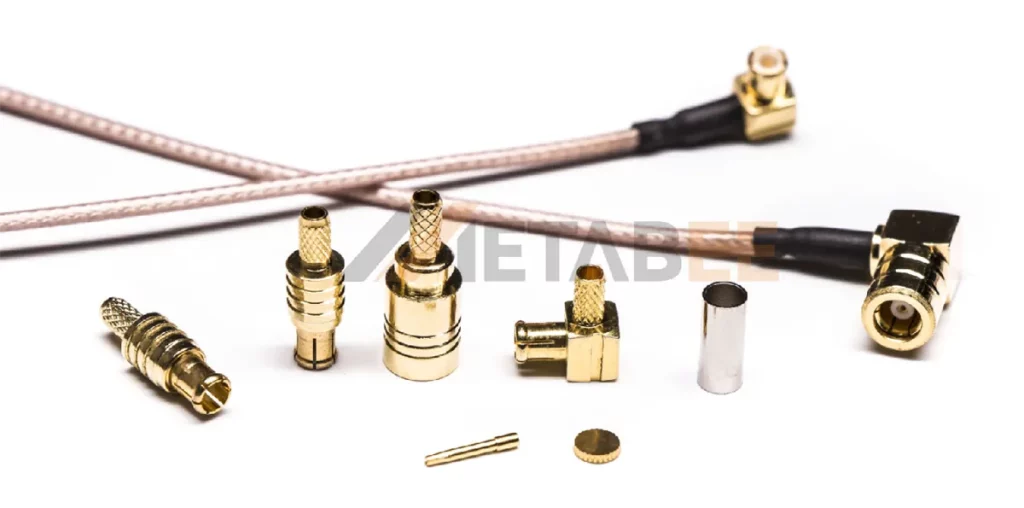
Definition
The SMB connector is a miniature coaxial connector designed for quick-connect/disconnect applications in RF and microwave systems. Developed in the 1960s as a smaller alternative to the SMA connector, it features a snap-on coupling mechanism instead of a threaded interface. It supports both 50-ohm and 75-ohm impedance systems and operates effectively at frequencies up to 4 GHz.
Standard
SMB connectors adhere to IEC-60169-10 and MIL-STD-348 industry standards. These standard outlines critical parameters, including connector interface dimensions, electrical ratings, and mating cycles. So these can ensure mechanical compatibility, consistent electrical performance, and interoperability between products from different manufacturers.
Design Mechanism and Materials
SMB connectors utilize a snap-on coupling mechanism, allowing for fast and reliable mating. This design can be rapidly installed without tools while maintaining good electrical contact and mechanical stability.
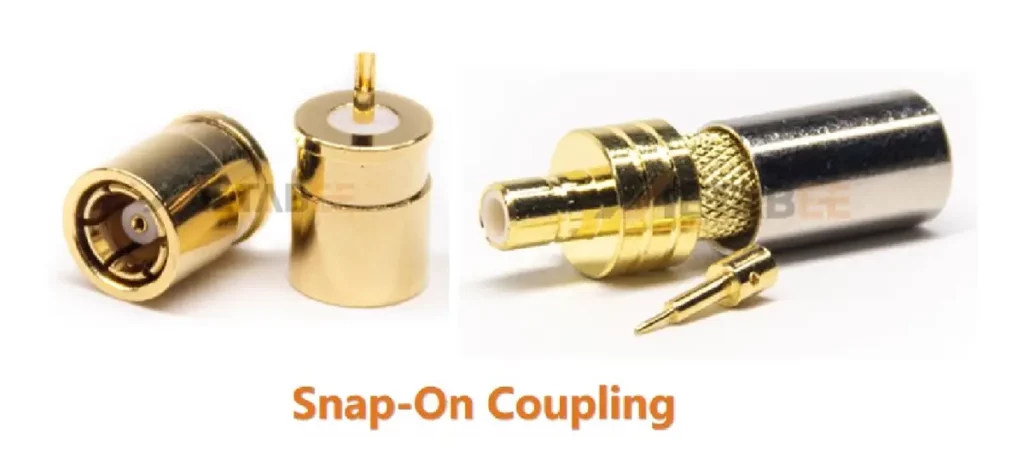
Structures and materials include:
- Shell: Copper with gold-plated or nickel-plated for durability.
- Contact: Brass with gold-plated for low resistance and corrosion resistance.
- Insulator: Teflon for stable insulation.
| Shell Material | Copper |
| Shell Plating | Gold-plated or Nickel-plated |
| Contact Material | Brass |
| Contact Plating | Gold-Plated |
| Insulator | Teflon |
Dimensions
SMB connectors are significantly smaller than SMA connectors. The small size of SMB connectors makes them suitable for high-density applications where space is limited.
Cable Sizes
There are available for two cable sizes of SMB connectors:
- Cable 2.6/50+75 S (3 mm outer / 1.7 mm inner diameter)
- Cable 2/50 S (2.2 mm outer / 1 mm inner diameter)
Interface Dimensions
According to the IEC 60169-10 standard, the SMB connector interface dimensions are as follows:
- The inner diameter of the SMB connector outer conductor is 3 mm (0.12 in)
- Outer diameter of interface (50 Ohm): Approximately 3.70 mm
- Outer diameter of interface (75 Ohm): Approximately 6.25 mm
Interface Dimensions of SMB Jack/Plug Connector:
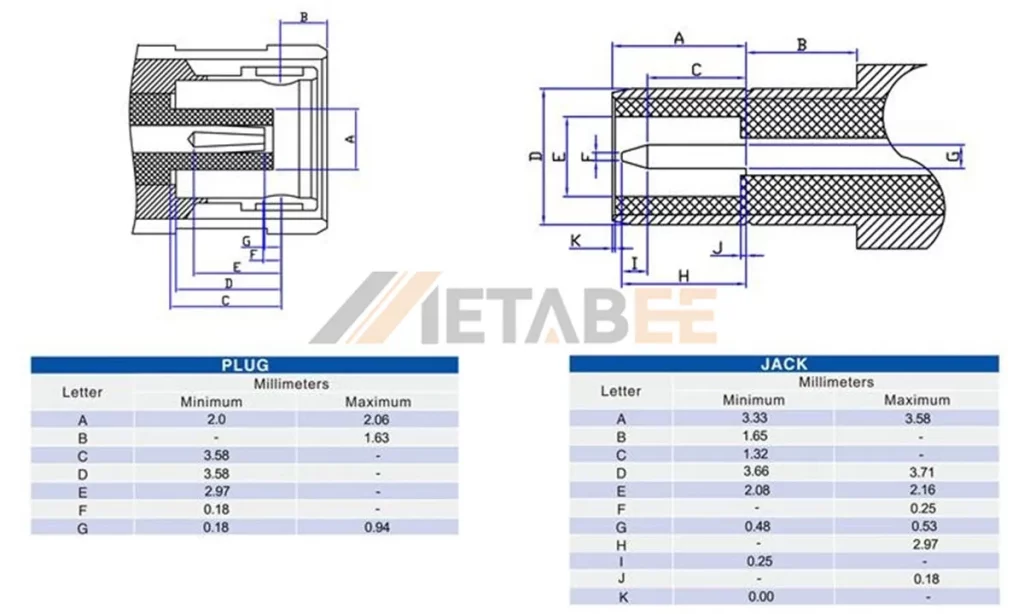
9 Common SMB Connector Types
SMB connectors are available in various configurations to meet different application requirements. We can divide them into 9 common types based on gender, mounting method, orientation, and impedance.
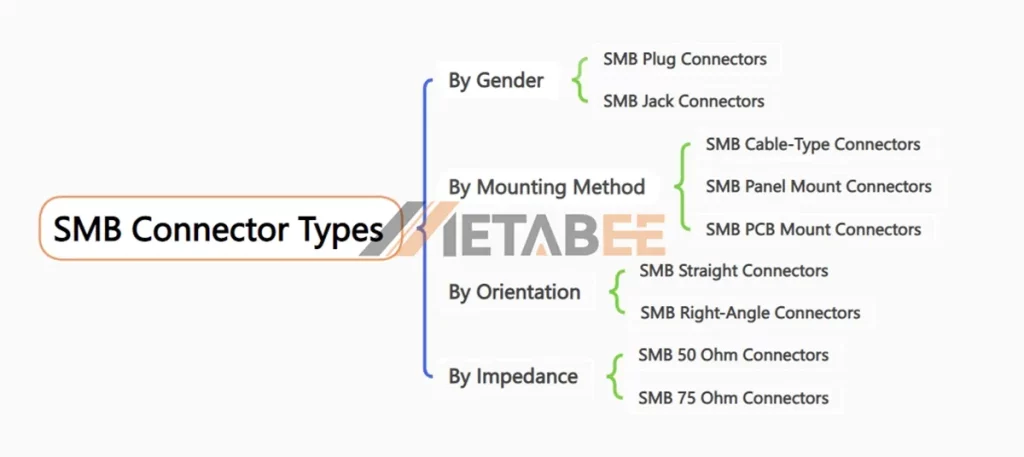
By Gender
SMB connectors are designed with specific gender configurations to ensure proper mating:
- Jack SMB Connectors: The contact is a center pin.
- Plug SMB Connectors: The contact is a center receptacle.
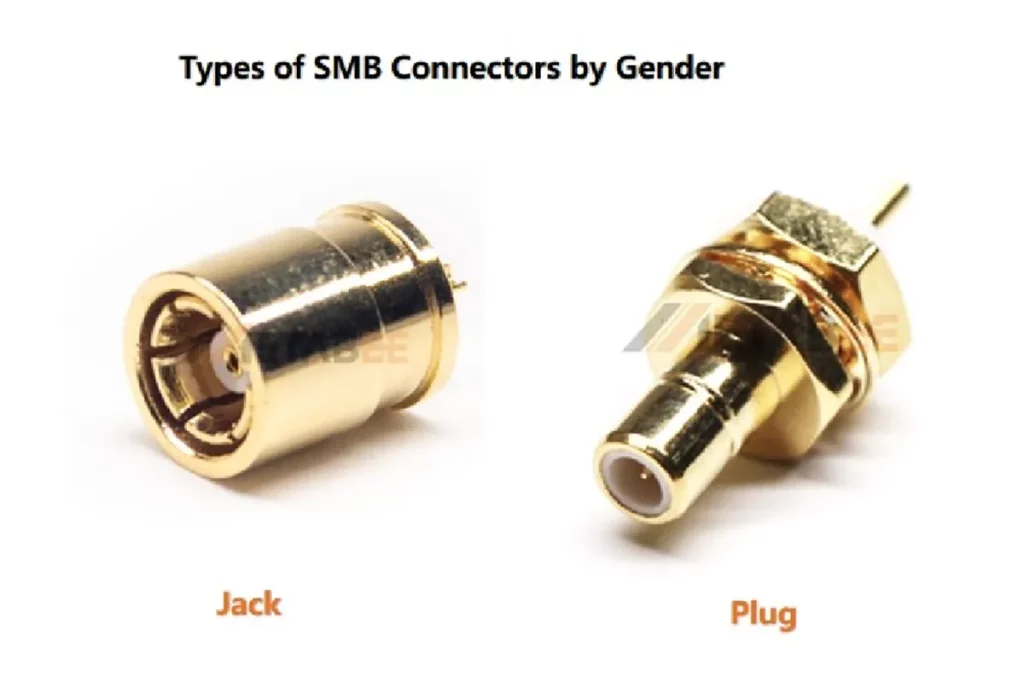
By Mounting Method
SMB connectors are available in various mounting styles to accommodate different installation requirements:
- Cable-Type SMB Connectors: These connectors are designed to terminate coaxial cables. They are available in crimp, solder, or clamp termination styles.
- Panel Mount SMB Connectors: These are mounted directly onto panels or enclosures via threaded nuts, providing a fixed interface for external connections. They can be categorized into bulkhead and 2-hole flange connectors.
- PCB Mount SMB connectors: These are soldered directly to PCBs with vertical or horizontal orientations. They are available in through-hole and edge-mount variants, making them suitable for compact electronic assemblies.
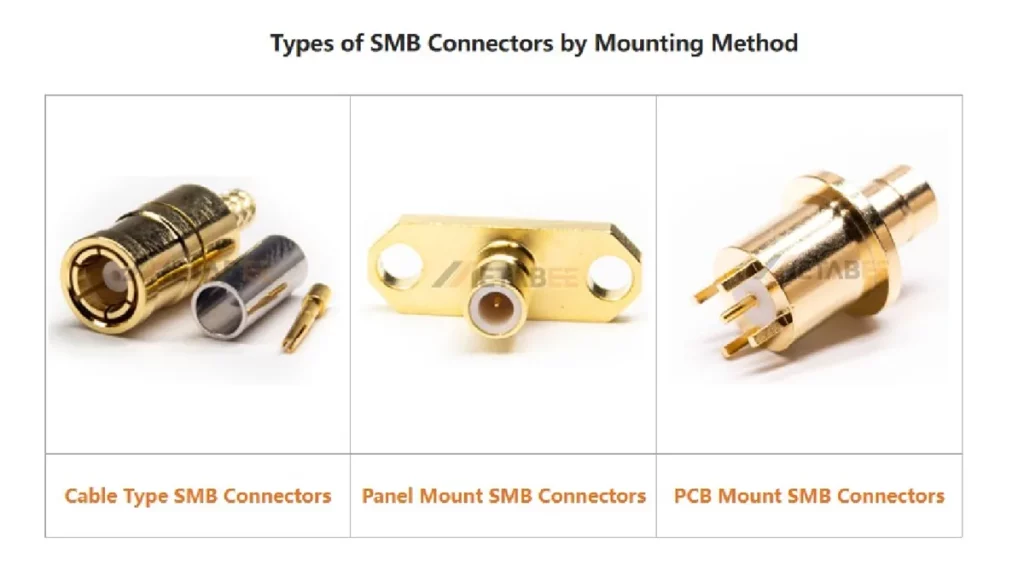
By Orientation
- Straight SMB Connectors: They offer a direct, in-line connection, minimizing signal loss, signal path length, and reflection.
- Right–Angle SMB Connectors: These are incredibly useful in applications with limited space.
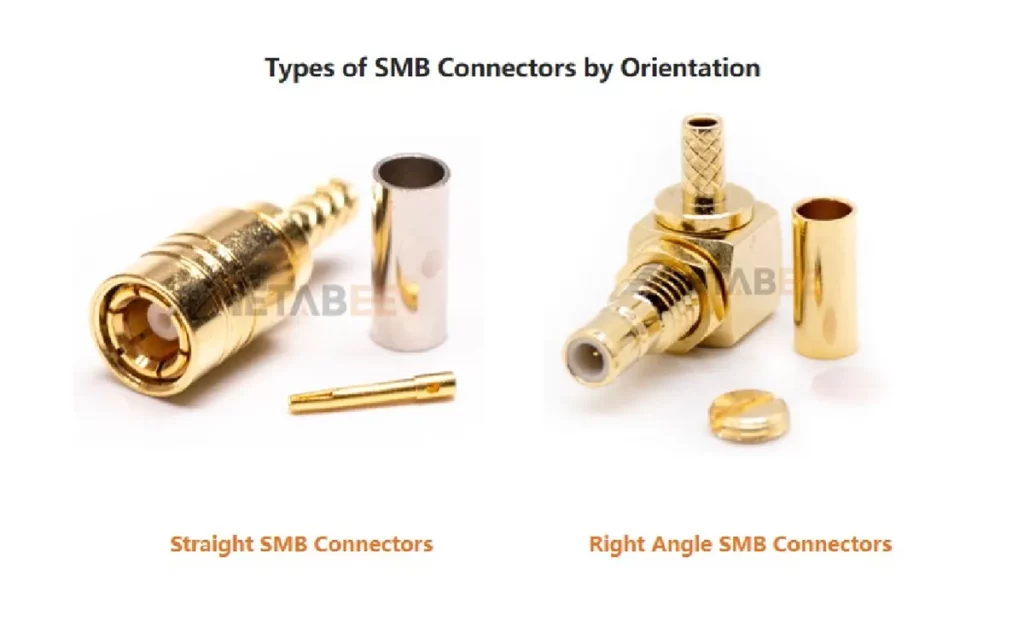
By Impedance
- 50 Ohm SMB Connectors: The majority of SMB connectors are designed for 50 Ohm impedance, which is the standard for most general RF and microwave applications.
- 75 Ohm SMB Connectors: They are primarily utilized in video transmission and broadcast systems.

SMB Connector Specification
SMB connectors are characterized by rigorous technical specifications that ensure reliable performance across various applications. Understanding these is crucial for selecting the right connector for a given application.
Electrical Characteristics
The electrical characteristics of an SMB connector dictate how well it transmits signals.
- Impedance: Available in 50 Ohm and 75 Ohm configurations, SMB connectors cater to different system requirements.
- Frequency Range: Standard 50 Ohm connectors operate effectively from DC up to 4 GHz; 75 Ohm connectors operate from DC to 2 GHz.
- VSWR: It indicates efficient signal transmission with minimal reflections. Straight connectors exhibit a VSWR of ≤1.3, while right-angle connectors have a VSWR of ≤1.5.
- Center Contact Resistance: This measures the resistance of the inner conductor connection. It is typically ≤6 mΩ.
- Outer Contact Resistance: This measures the resistance of the outer conductor connection. It is typically ≤1.5 mΩ.
- Insulation Resistance: SMB connectors offer high insulation resistance, commonly ≥1000 MΩ, ensuring minimal leakage currents and enhanced performance.
| Impedance | 50 Ohm or 75 Ohm |
| Frequency Range | DC to 4 GHz for 50 Ohm DC to 2 GHz for 75 Ohm |
| VSWR | Straight Type ≤1.3 Right-Angle type ≤1.5 |
| Center Contact Resistance | ≦ 6.0 mΩ (Milliohms MAX . ) |
| Outer Contact Resistance | ≦ 1.5 mΩ (Milliohms MAX . ) |
| Insulation Resistance | ≧ 1000 MΩ (Megohms MIN . ) |
Mechanical Characteristics
The mechanical attributes define the physical integrity and durability of the connector.
- Coupling Mechanism: SMB connectors feature a snap-on coupling mechanism. This design allows for quick and easy mating and un-mating and provides a secure connection.
- Contact Retention: The center contact retention force is generally 4 lbs min, ensuring stable electrical contact under mechanical stresses.
- Durability: SMB connectors are designed for a specified number of mating cycles, typically around 500 cycles, while maintaining their electrical and mechanical performance.
| Coupling | Snap on |
| Contact Retention | 6 lbs MIN . |
| Coupling Nut Torque | 6 lbs MIN . |
| Durability (Mating) | 30 in-lbs. MIN . |
Environmental Characteristics
These specifications detail how the connector performs under various environmental conditions.
- Temperature Range: SMB connectors operate reliably within a temperature range of −65℃ to +155℃, accommodating various environmental conditions
- Vibration: The design of SMB connectors can withstand significant vibration and is compliant with MIL-STD-202, Method 204.
- Corrosion Resistance: Tested per MIL-STD-202 Method 101, SMB connectors resist corrosion, ensuring longevity even in harsh conditions.
SMB Connector Applications
SMB connectors are widely utilized in a variety of applications, including:
- Telecommunications: Base stations, antennas, and networking equipment.
- GPS Systems: Antennas and receivers.
- Automotive: Infotainment systems, GPS, and cellular connectivity.
- Test and Measurement: RF test equipment and instruments.
- Medical Equipment: Patient monitoring wireless telemetry equipment, RF ablation and electrosurgical tools, Medical Imaging ultrasound systems connections.
- Industrial Controls and Automation: Various industrial sensing and control systems.
- Consumer Electronics: GPS units and wireless communication equipment, smaller devices requiring RF connectivity.
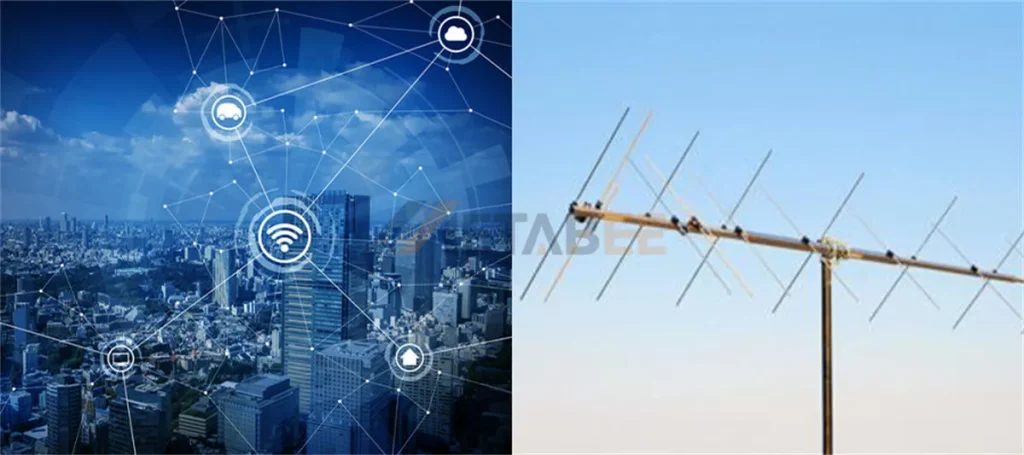
SMA vs. SMB vs. SMC
SMA, SMB, and SMC connectors are three popular subminiature RF coaxial connectors. But each has distinct characteristics that make it suitable for different applications. Understanding their differences in size, coupling mechanism, and frequency range is crucial for proper selection.
SMA vs. SMB Connector
The key distinctions between SMA and SMB connectors lie in their coupling mechanism and frequency performance.
The differences and similarities between the two connectors are as follows:
| Feature | SMA Connector | SMB Connector |
|---|---|---|
| Full Form | Sub-Miniature Version A | Sub-Miniature Version B |
| Coupling Mechanism | Threaded Coupling | Snap-On Coupling |
| Frequency Range | DC to 18 GHz | DC to 4 GHz |
| Impedance | 50 Ohm | 50 Ohm or 75 Ohm |
| Shell | Copper Alloy | Copper |
| Shell Plating | Nickel-Plated/Gold-Plated | Nickel-Plated/Gold-Plated |
| Contact | Phosphor Bronze | Brass |
| Contact Plating | Gold-Plated | Gold-Plated |
| Connector Size | Larger | Smaller |
| Price | Moderate | Lower |
| Application | High-Frequency, High-Performance Applications, Precision Systems | General-Purpose RF Applications, Compact, Quick-Connect Applications |
| Insulator | Teflon | |
| Temperature Range | -65℃ to +155℃ | |
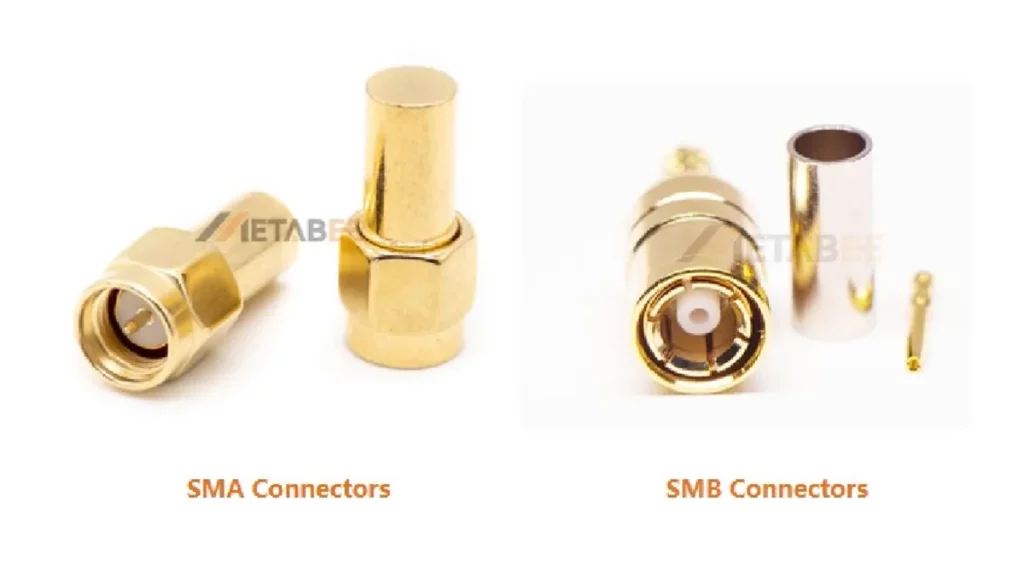
SMB vs. SMC Connector
Their key difference is in their coupling method, which impacts their mechanical robustness and suitability for various environments. The SMC connector is similar in structure to the SMB connector. It is a threaded variant of the SMB connector.
The differences and similarities between the two connectors are as follows:
| Feature | SMB Connector | SMC Connector |
|---|---|---|
| Full Form | Sub-Miniature Version B | Sub-Miniature Version C |
| Coupling Mechanism | Snap-On Coupling | Threaded Coupling |
| Frequency Range | DC to 4 GHz | DC to 10 GHz |
| Connector Size | Larger | Smaller |
| Price | Lower | Higher |
| Application | Consumer Electronics, Automotive, Quick-Connect RF Systems | Aerospace, Military, High-Vibration Environments |
| Impedance | 50 Ohm or 75 Ohm | |

The Main SMB Connector Factories and Manufacturers
Some of the leading and well-known manufacturers include:
- Amphenol. A global leader in interconnect solutions, offering a wide range of RF connectors including SMB.
- TE Connectivity. Known for its reliable and innovative connectivity solutions. They serve a broad spectrum of industries with high-quality components.
- Radiall. A well-known manufacturer specializing in RF coaxial connectors
- Metabee. A Chinese manufacturer known for its range of electronic connectors. We aim to provide a broad array of connectors and cable assemblies, including SMB connectors.
- Renhotec. As a leading manufacturer, they offer competitive and reliable RF connector solutions that strike a balance between performance and cost-effectiveness.
- Rosenberger. Known for precision RF connectors, including SMB variants.
Conclusion
The SMB connector stands out as a vital component in the world of RF coaxial connections. Their compact size, snap-on coupling, and robust design make them a preferred choice for quick assembly applications. And they strike a balance between performance and cost-effectiveness. Available in both 50 Ohm and Ohm impedance versions, they typically operate effectively up to 4 GHz. With various configurations and specifications, they cater to a broad spectrum of industries.
This article explores their definition, standards, design, dimensions, types. We details their electrical, mechanical, and environmental specifications. A comparative analysis with SMA and SMC connectors highlights their respective unique features. What’s more, we also list key applications of SMB connectors, well-known manufacturers and related products.
Related Products
- SMB Connectors
- SMA Connectors
- SMC Connectors
- SMB Adapters
- SMA Adapters
- SMB Cable Assemblies
- SMA Cable Assemblies
- SMC Cable Assemblies